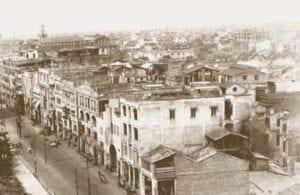“Veranda”, a not so accurate translation of Qilou(骑楼) can not fully encapsulate the profound history and architectural genius embedded in these old buildings scattered around cities in Southern China. Originated from South East Asia, where the weather is hot and humid year-round, Qilou is a semi-open architectural form that provide both living and commercial space. With its extended roof, Qilou shields pedestrian from sunlight and rain so they can walk comfortably while the store owners can have more shop windows to display their merchandise. Second story and above are often utilized for housing where residents are able to avoid hot air. Such design integrates European (mostly Spanish) and East Asian architectural elements and can be easily adjusted accordingly to the local customs and natural conditions.

For these reasons, Qilou became instantly popular once introduced to Canton in 1920s and among other southern city in China like Zhongshan, Xiamen, Shanghai and so on for the following decades. These buildings were built every where in small towns and city centers and hosted a considerable amount of small businesses which definitely includes street foods.
However in recent years, we observed a sharp decline in businesses based in these buildings. Take my hometown Shunde as an example, the decay of Qilou started around 2007 when shopping centers and mega malls entered consumers’ eyes of this medium-sized town in Guangdong. Before then, the buildings of Qilou were the venue where people went for entertainment, shopping and dining. Especially for visitors who traveled to Shunde, the shopping street formed with Qilou was the must-go place as these buildings only existed in the southern part of China and were seen as representation of Cantonese architectures. These buildings witnessed the social and economic development for decades and yet they were immediately replaced when shopping malls are introduced. Without a doubt, a new and organized venue like shopping malls will attract more customers than small shops that were set up under the old roofs. These malls provide a better environment for their customers to enjoy their shopping experience like high-end stores and restaurants, clean bathrooms, parking services and so on. All of these come with a price that landlords charge the store owner and eventually transfer to customers. Nevertheless, customers are still willing to pay the price because consumption models of ordinary people has changed over the years. In this day and age, people are more inclined to buy things online, necessities like foods and clothes in particular that were usually purchased in local shopping streets in the past. Shopping malls still stand a chance when it comes to luxury goods and high-end restaurants. For physical businesses that located in Qilou, they are not able to compete with the internet for the price nor the malls for shopping experience. That is why even though the rent for shops at Qilou are low, many businesses are not capable of surviving and thus have to shut down. It was such a pity that a great proportion of these businesses just vanished because they used to be an important component of our life.
That being said, there are exceptions where Qilou regains vitality with proper renovations. Wukang Mansion, a prominent Qilou located in Xuhui District is a great example. Last year, the building was under renovation for four months and reopened with huge success, becoming the new landmark of Shanghai.
See this link: https://www.shine.cn/news/in-focus/2007172404/
Leave a Reply